Zur Frage der Neuartigen Komposita im Deutschen und im Litauischen
On New Compounds in German and Lithuanian Languages
Author(s): Ernesta RačienėSubject(s): Language and Literature Studies
Published by: Vilnius Gediminas Technical University
Keywords: language of the press and new medium; an intercultural comparison of languages; neologisms; occasional compounds; compounds with foreign word components
Summary/Abstract: In the present article, the usage patterns of compound neologisms and occasional compounds in German and Lithuanian media languages of the press and new medium are analysed and compared in terms of intercultural aspects. In the current development stage, German and Lithuanian languages undergo rapid changes, acquire new forms and are constantly affected by other languages. Furthermore, they experience processes of globalization and internationalization. The discourse of the press and new medium is the most instant reflection of political, economical, social and cultural changes in public life. It is rich with neologisms and occasional compounds. As written language on the Internet resembles spoken language, these language varieties are said to demonstrate characteristics of a spoken language. Bindestrichkomposita - hyphenated occasional compound nouns - are widely used in German Internet language. The article overviews common structural models of such compounds and provides a lot of examples of their usage. Such compounds in Lithuanian language are not so common in comparison to German; however, their rapid spread and derivation is also apparent in Lithuanian press and electronic discourse. This reflects flexibility and creative potential of a language. In recent decades in German language, there has been an active use of compounds which have foreign word components, often deriving from Greek and Latin languages. Similarly, in Lithuanian language, an increasing number of compounds with foreign word components can be identified. The study compares the use of these compounds in German and Lithuanian languages by highlighting similarities and differences.
Journal: Santalka: Filologija, Edukologija
- Issue Year: 20/2012
- Issue No: 1
- Page Range: 85-97
- Page Count: 13
- Language: German

